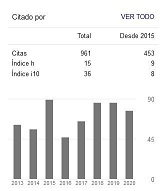Anthelminthic Effect of Dichrostachys cinerea on Infectious L3 Larvae of Cyathostomes Resistant to Albendazol.
Resumen
In vitro anthelminthic effect of raw aqueous extracts from leaves and bark of Dichrostachys cinerea on infectious L3 larvae of Cyathostomes resistant to Albendazol was evaluated. An inhibition assay for larval hatching was made. Third-stage larvae (L3) were exposed to raw aqueous extracts from leaves (4 mg/ml), and bark (6.8 mg/ml) of Dichrostachys cinerea, for three hours, then hatching was induced. Observations were made every 10 min. Paired T-Student was used to determine the differences in per cent of hatched larvae between the control and the treatment groups. GraphPadPrism 5.0.0 was used in the study. Significant inhibition levels were observed in all the extracts (P < 0.05) during the process; whereas hatching in the control group was 100 %, for the leaf and bark extracts of D. cinerea were 24.05, and 12.56 %, respectively. The results suggest the use of D. cinerea as an alternative anthelminthic treatment to Albendazol-resistant Cyasthostome populations.Descargas
Citas
ALONSO-DÍAZ, M. A.; TORRES-ACOSTA, J. F.; SANDOVAL-CASTRO, C. A.; AGUILAR-CABALLERO, A. J. y HOSTE, H. (2008). In vitro Larval Migration and Kinetics of Exsheathment of Haemonchus contortus Larvae Exposed to Four Tropical Tanniniferous Plant Extracts. Vet. Parasitol., 153, 313-319.
ALONSO-DÍAZ, M. A.; TORRES-ACOSTA, J. F.; SANDOVAL-CASTRO, C. A. y HOSTE, H. (2011). Comparing the Sensitivity of Two In Vitro Assays to Evaluate the Anthelmintic Activity of Tropical Tannin rich Plant Extracts Against Haemonchus contortus, Veterinary Parasitology, 181, 360-364.
ATHANASIADOU, S. y KYRIAZAKIS, I. (2004). Plant Secondary Metabolites: Antiparasitic Effects and Their Role in Ruminant Production Systems, P. Nutr. Soc., 63, 631-639.
BAHUAUD, D.; MARTÍNEZ-ORTIZ de MONTELLANO, C.; CHAVEAU, S.; PREVOT, F.; TORRES-ACOSTA, F.; FOURASTE, I. et al.(2006). Effects of Four Tanniferous Plant Extracts on the In Vitro Exsheathment of Third-Stage Larvae of Parasitic Nematodes. Parasitology, 132, 545-554.
BRUNET, S.; AUFRERE, J.; EL BABILI, F.; FOURASTE, I. y HOSTE, H. (2007). The Kinetics of Exsheathment of Infective Nematode Larvae is Disturbed in the Presence of a Tannin-Rich Plant Extract (Sainfoin) Both In Vitro and In Vivo, Parasitology, 134, 1253-1262.
BRUNET, S.; MARTÍNEZ-ORTIZ de MONTELLANO, C.; TORRES-ACOSTA, J. F.; SANDOVAL-CASTRO, C. A.; AGUILAR-CABALLERO, A. J.; CAPETILLO-LEAL, C. et al. (2008). Effect of the consumption of Lysilo-ma latisiliquum on the larval establishment of para-sitic nematodes in goats, Vet. Parasitol., 157, 81-8.
COSTA, C. T.; MORAIS, S. M.; BEVILAQUA, C. M.; SOUZA, M. M. y LEITE, F. K. (2002). Efeito ovicida de extratos de sementes de Mangifera indica L. so-bre Haemonchuscontortus. Rev. Bras. Parasitol. Vet., 11, 5-60.
DALZIELD, J. M. (1948). The Useful Plants of West Tropical Africa. Westminster, Londres: The Crown Agents for the Colonies.
DOMÍNGUEZ, S. X. (1979). Métodos de investigación fitoquímica. México, D. F.: Ed. Limusa S. A.
GITHIORI, J. B.; ATHANASIADOU, S. y THAMSBORG, S. M. (2006). Use of plants in novel approaches for control of gastrointestinal helminths in livestock with emphasis on small ruminants, Vet. Parasitol., 139, 308-320.
HOSTE, H.; JACKSON, F.; ATHANASIADOU, S.; THAMSBORG, S.M. y HOSKIN, S.O. (2006). The effects of tannin-rich plants on parasitic nematodes in ruminants. Trends Parasitol., 22, 253-261.
IQBAL, Z.; SARWAR, M.; JABBAR, A.; AHMED, S.; NISA, M.; SAJID, M.S.et al. (2007). Direct and Indi-rect Anthelmintic Effects of Condensed Tannins in Sheep. Vet. Parasitol., 144, 125-131.
KAPLAN, R.M. (2004). Drug Resistance in Nematodes of Veterinary Importance: a Status Report, Trends Parasitol., 20, 477-481.
KAPLAN, R. M. y NIELSEN, M. K. (2010). An Evidence-Based Approach to Equine Parasite Control: it Ain’t the 60s Anymore. Equine Vet. Educ., 22, 306-316.
KUZ’MINA, T. A. (2012). Strongylids (Nematoda: Strongylidae) of Domestic Horses in Ukraine: Modern State of Fauna and Structure of the Parasite Community. Parazitologia, 46, 127-138.
MAIR, T.S. (1994). Outbreak of Larval Cyathostomiasis Among a Group of Yearling and Two-Year-Old Horses, Vet. Rec., 135, 598-600.
MARIE-MAGDELEINE, C.; HOSTE, H.; MAHIEU, M.;VARO, H. y ARCHIMEDE, H.(2009). In vitro Ef-fects of Cucurbita moschata seed Extracts on Haemonchus contortus, Vet. Parasitol., 161, 99-105.
MATTHEWS, J. B.(2008). An Update on Cyathostomins: Anthelmintic Resistance and Worm Control. Eq. Vet. Educ., 20, 552-560.
MATTHEWS, J. B. (2014). The Future of Helminth Control in Horses. Equine Vet. J., 46, 10-11.
MOLENTO, M.; SILVA, F.; ARAUJO, D.; BORGES, F.; CHAGAS, A.; TORRES-ACOSTA, J. F. et al. (2011). Challenges of Nematode Control in Ruminants: Focus on Latin America, Veterinary Parasitology, 180, 126-132.
MONAHAN, C. M.; CHAPMAN, M. R.; TAYLOR, H. W.; FRENCH, D. D y KLEI, T. R. (1996). Comparison of Moxidectin Oral Gel and Ivermectin Oral Paste Against a Spectrum of Internal Parasites of Ponies with Special Attention to Encysted Cyathostome Larvae. Vet. Parasitol., 63, 225-235.
MURPHY, D y LOVE, S (1997). The Pathogenic Effects of Experimental Cyathostome Infections in Ponies. Vet. Parasitol., 70, 99-110.
PARRY, J. M.;FISHER, M. A.;GRIMSHAW, W.T. y JACOBS, D.E. (1993). Anthelmintic Dosing Inter-vals for Horses: Comparison of Three Chemical Groups. Vet. Rec., 133, 346-347.
RELF, V. E.; MORGAN, E. R.; HODGKINSON, J.E. y MATTHEWS, J. B. (2013). Helminth Excretion with Regard to Age, Gender and Management Practices on UK Thoroughbred Studs, Parasitology, 140, 641-652.
ROIG MESA, J. T. (1974). Plantas medicinales, aromáticas y venenosas de Cuba. La Habana, Cuba: Edi-torial Ciencia y Técnica.
Los autores de los artículos publicados en RPA retienen los derechos de autor de su trabajo, de marca y patente, y también sobre cualquier proceso o procedimiento descrito en el artículo, así como a compartir, copiar, distribuir, ejecutar y comunicar públicamente el artículo publicado en la RPA o cualquier parte de aquel siempre que indiquen la fuente de publicación (autores del trabajo, revista, volumen, número y fecha), pero están de acuerdo en que la revista publique los trabajos bajo una licencia Creative Commons.
![]() Licencia Attribution-NonCommercial 4.0 International (CC BY-NC 4.0)
Licencia Attribution-NonCommercial 4.0 International (CC BY-NC 4.0)






































